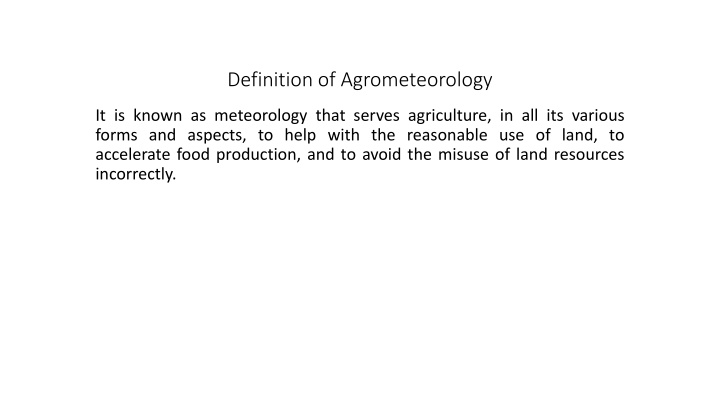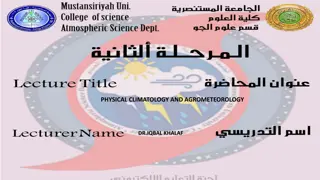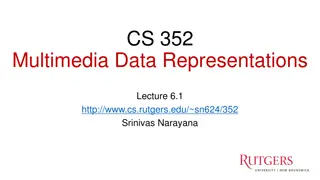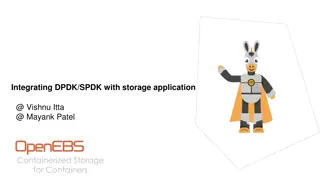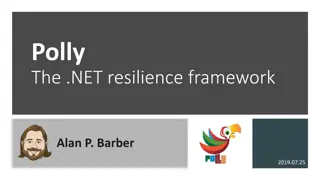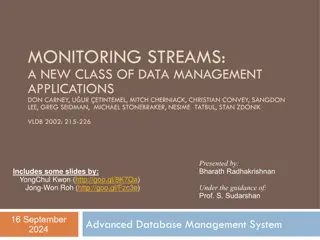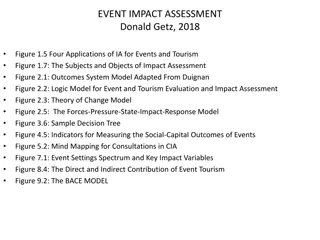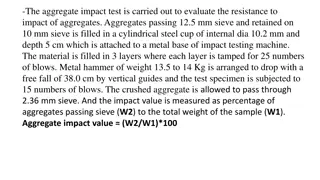Insights into Agrometeorology: Importance, Applications, and Impact
Agrometeorology serves agriculture by aiding in land use, food production, and resource management. It plays a crucial role in strategic agricultural decisions, such as irrigation schemes, crop selection, and machinery use. Weather forecasts and climate patterns are key for effective planning, especially in the face of increasing climate variability and extreme events. Forest meteorology is also highlighted for its role in protecting forests and combating forest fires. Developing countries face unique challenges in agricultural practices and require tailored agrometeorological services to address changing needs.
Download Presentation

Please find below an Image/Link to download the presentation.
The content on the website is provided AS IS for your information and personal use only. It may not be sold, licensed, or shared on other websites without obtaining consent from the author.If you encounter any issues during the download, it is possible that the publisher has removed the file from their server.
You are allowed to download the files provided on this website for personal or commercial use, subject to the condition that they are used lawfully. All files are the property of their respective owners.
The content on the website is provided AS IS for your information and personal use only. It may not be sold, licensed, or shared on other websites without obtaining consent from the author.
E N D
Presentation Transcript
Definition of Agrometeorology It is known as meteorology that serves agriculture, in all its various forms and aspects, to help with the reasonable use of land, to accelerate food production, and to avoid the misuse of land resources incorrectly.
Importance and applications of Agrometeorology No branch of human activities depends on the weather such as agriculture. Agricultural production continues to depend largely on weather and climate despite tremendous advances in agricultural technology over half a century. Agrometeorological services have become essential because of the challenges provided to many forms of agricultural production by increasing climate variability and associated extreme events as well as climate change, all of which affecting the socio-economic conditions, especially of developing countries. Full knowledge of the time and place of available environmental resources and the general conditions of soil and subsoil by knowing the soil and air in the boundary layer of the atmosphere, whether favorable or unfavorable conditions, provide guidance for strategic agricultural meteorological decisions in the long-term planning of agricultural systems Examples include irrigation and drainage scheme designs, land use and farming patterns, and crop and animal choices, varieties and breeds, and agricultural machinery.
Applications Applications The practical application of this knowledge is linked to the availability and accuracy of weather and climate forecasts or expected weather and climate patterns, depending on the time scale. The requirements range from accurate details of short-range weather forecasts (less than two days), medium range forecasts (less than ten days) at certain critical times to seasonal predictions of climate patterns. To ensure that development plans are not rendered meaningless by a significant change in weather and climate behavior, indications of possible climatic variability, and of increasingly frequent and serious extreme events in the context of global climate change, are necessary as agrometeorological services in addition to the application of other agrometeorological information. Although reliable long-term weather forecasts relevant to the agricultural community are not yet available on a routine basis all over the world, significant services may be provided by means of agrometeorological forecasts such as on the dates of phonological events, the quantity and quality of crop yields, and the occurrence of animal and crop epidemics.
and the occurrence of animal and crop epidemics. These forecasts make use of established relationships between weather effects at an early stage of development and the final event expected sometime after the date of issue of the forecast. The global climate is influenced by a lot of factors Two of the most important - : - 1 components are CO2 - 2 water vapor in the atmosphere. Beside the oceans, forests absorb CO2 and release water vapor. Burning forests produce considerable masses of CO2 So it is necessary to promote reforestation and protect forests against fire and human beings as well as against other destruction, such as by insects, diseases and pollutants. Forest meteorology as a component of agrometeorology provides useful information and services for application to the forest authorities, the foresters and in case of forest fires to the fire-brigades. Agrometeorological services in developing countries have to shoulder greater responsibilities due to greater population pressure and changing modes of agricultural practices.
More and more demands pertaining to agrometeorological information and services are expected from the farming communities in the future on technologies, farming systems patterns, water management, weather based pest and disease control etc., preferably with local innovations as starting points. Thus the future challenges include the necessity to emphasize a bottom up approach so that forecasts, specific advisories and contingency planning reach even the small farmers for applications in their planning and day-to-day agricultural operations. Agrometeorological services in developed countries focus on the provision of environmental data and information to national policy and decision makers in support of sustained food production, sustainable development, carbon sequestration in agro-ecosystems and land management practices that affect exchange processes of greenhouse gasses. Because developed countries may have or develop technology to initially adapt more readily to climate change and climate variability, technology transfer may play a certain role but local innovations remain most important for application under the very different conditions in developing countries
Organizations such as WMO, FAO and INSAM are playing a role, and will have to play an increasing role, in stimulating development and establishment of agrometeorological services and dissemination of agrometeorological information. Advisories include among others (i) in drier climates information on average sowing date as well as expected sowing dates for the ongoing season, at various temporal and spatial scales, as well as on operational crop protection of all kinds (ii) in more humid climates information on pest and diseases attacks, all based on weather information and agrometeorological services in location specific and user-friendly format. Other important advisory fields that require attention are:
Management and modification of microclimate. Meteorological information for guiding irrigation and drainage. Environmental risks and disaster mitigation. Highland and mountain agriculture. Prediction of El-Nino and rainfall variability for agricultural planning. Information on weather based pesticides/insecticides applications. Arial transport of pollutants and knowledge regarding low level winds for operational activities. Workday probabilities (e.g. in marine and lake fishing). Agro advisory services for farmers on a regional level to strengthen and provide accurate forecasts and advisories for the farming community. Communication of information in a format/language understandable to users.
In more advanced agricultural production, with potential for technology transfer where the absorption capacity exists, we may add: Crop weather modelling with special emphasis on crop growth simulation models. Development of complex data collection systems and speedy processing and interpretation of large spatial data collections. Geographical information systems and their use for crop planning at smaller than present scales. The use of remote sensing technologies to generate information/ advisories for large areas. Quantifying Carbon sequestration.
